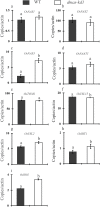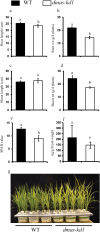Paralogs and mutants show that one DMA synthase functions in iron homeostasis in rice
- PMID: 28369596
- PMCID: PMC5444454
- DOI: 10.1093/jxb/erx065
Paralogs and mutants show that one DMA synthase functions in iron homeostasis in rice
Abstract
Rice (Oryza sativa) secretes 2'-deoxymugineic acid (DMA) to acquire insoluble iron (Fe) from the rhizosphere. In rice, DMA is synthesized by DMA synthase 1 (OsDMAS1), a member of the aldo-keto reductase super family. We screened OsDMAS1 paralogs for DMA synthesis. None of these paralogs displayed in vitro DMA synthesis activity, suggesting that rice only harbors one functional DMAS. We further characterized OsDMAS1 mutant plants. We failed to screen homozygous knock-out plants (dmas-1), so we characterized DMAS knock-down plants (dmas-kd1 and dmas-kd2). Under Fe-deficient conditions, dmas-kd1 plants were more chlorotic compared to the wild-type (WT) plants, and the expression of OsNAS3, OsYSL2, OsIRT1, and OsIRO2 was significantly up-regulated in the dmas-kd1 mutant, indicating that metal homeostasis was significantly disturbed. The secretion of DMA in dmas-kd1 was not significantly reduced. The dmas-kd1 plants accumulated less Fe in their roots compared to WT plants when grown with 10 μM FeSO4. The dmas-kd1 plants accumulated more Zn in their roots compared to WT plants under Fe-deficient, Fe-EDTA, and FeSO4 conditions. In both dehusked rice seeds (brown rice) and polished rice, no differences were observed for Fe, Cu, or Mn accumulation, whereas dmas-kd1 seeds significantly accumulated more Zn in brown rice. Our data suggests that rice only harbors one functional gene for DMA synthesis. In addition, the knock-down of OsDMAS1 significantly up-regulates the genes involved in Fe uptake and homeostasis.
Keywords: Aldo-keto reductase; DMA; Oryza sativa; deoxymugineic acid synthase; iron; iron deficiency; phytosiderophores; zinc..
© The Author 2017. Published by Oxford University Press on behalf of the Society for Experimental Biology.
Figures






Similar articles
-
The expression of iron homeostasis-related genes during rice germination.Plant Mol Biol. 2007 May;64(1-2):35-47. doi: 10.1007/s11103-007-9132-4. Epub 2007 Mar 2. Plant Mol Biol. 2007. PMID: 17333504
-
Cloning and characterization of deoxymugineic acid synthase genes from graminaceous plants.J Biol Chem. 2006 Oct 27;281(43):32395-402. doi: 10.1074/jbc.M604133200. Epub 2006 Aug 22. J Biol Chem. 2006. PMID: 16926158
-
Deoxymugineic acid increases Zn translocation in Zn-deficient rice plants.Plant Mol Biol. 2008 Apr;66(6):609-17. doi: 10.1007/s11103-008-9292-x. Epub 2008 Jan 26. Plant Mol Biol. 2008. PMID: 18224446 Free PMC article.
-
The Molecular Mechanisms Underlying Iron Deficiency Responses in Rice.Int J Mol Sci. 2019 Dec 19;21(1):43. doi: 10.3390/ijms21010043. Int J Mol Sci. 2019. PMID: 31861687 Free PMC article. Review.
-
The Adaptive Mechanism of Plants to Iron Deficiency via Iron Uptake, Transport, and Homeostasis.Int J Mol Sci. 2019 May 16;20(10):2424. doi: 10.3390/ijms20102424. Int J Mol Sci. 2019. PMID: 31100819 Free PMC article. Review.
Cited by
-
Maize Interveinal Chlorosis 1 links the Yang Cycle and Fe homeostasis through Nicotianamine biosynthesis.Plant Physiol. 2022 Mar 28;188(4):2131-2145. doi: 10.1093/plphys/kiac009. Plant Physiol. 2022. PMID: 35099564 Free PMC article.
-
Genome-wide analysis of the NAAT, DMAS, TOM, and ENA gene families in maize suggests their roles in mediating iron homeostasis.BMC Plant Biol. 2022 Jan 17;22(1):37. doi: 10.1186/s12870-021-03422-7. BMC Plant Biol. 2022. PMID: 35039017 Free PMC article.
-
OsbHLH062 regulates iron homeostasis by inhibiting iron deficiency responses in rice.aBIOTECH. 2025 Mar 3;6(2):215-231. doi: 10.1007/s42994-025-00203-w. eCollection 2025 Jun. aBIOTECH. 2025. PMID: 40641637 Free PMC article.
-
Strategies and Bottlenecks in Hexaploid Wheat to Mobilize Soil Iron to Grains.Front Plant Sci. 2022 Apr 29;13:863849. doi: 10.3389/fpls.2022.863849. eCollection 2022. Front Plant Sci. 2022. PMID: 35574143 Free PMC article. Review.
-
Tolerance of Iron-Deficient and -Toxic Soil Conditions in Rice.Plants (Basel). 2019 Jan 28;8(2):31. doi: 10.3390/plants8020031. Plants (Basel). 2019. PMID: 30696039 Free PMC article. Review.
References
-
- Ariga T, Hazama K, Yanagisawa S, Yoneyama T. 2014. Chemical forms of iron in xylem sap from graminaceous and non-graminaceous plants. Soil Science and Plant Nutrition 60, 460–469.
-
- Bashir K, Inoue H, Nagasaka S, Takahashi M, Nakanishi H, Mori S, Nishizawa NK. 2006. Cloning and characterization of deoxymugineic acid synthase genes from graminaceous plants. The Journal of Biological Chemistry 281, 32395–32402. - PubMed
-
- Bashir K, Ishimaru Y, Nishizawa N. 2010. Iron uptake and loading into rice grains. Rice 3, 122–130.
-
- Bashir K, Ishimaru Y, Nishizawa N. 2012. Molecular mechanisms of zinc uptake and translocation in rice. Plant and Soil 361, 189–201.
MeSH terms
Substances
LinkOut - more resources
Full Text Sources
Other Literature Sources
Medical

